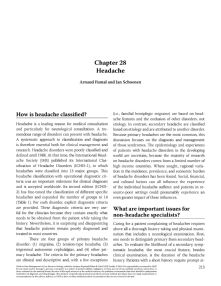Page 225 Guide to Pain Management in Low-Resource Settings
P. 225
Chapter 28
Headache
Arnaud Fumal and Jan Schoenen
How is headache classifi ed? (i.e., familial hemiplegic migraine) are based on head-
ache features and the exclusion of other disorders, not
Headache is a leading reason for medical consultation etiology. In contrast, secondary headache are classifi ed
and particularly for neurological consultation. A tre- based on etiology and are attributed to another disorder.
mendous range of disorders can present with headache. Because primary headaches are the most common, this
A systematic approach to classifi cation and diagnosis discussion focuses on the diagnosis and management
is therefore essential both for clinical management and of those syndromes. Th e epidemiology and experiences
research. Headache disorders were poorly classifi ed and of patients with headache disorders in the developing
defi ned until 1988. At that time, the International Head- world are uncertain, because the majority of research
ache Society (IHS) published its International Clas- on headache disorders comes from a limited number of
sifi cation of Headache Disorders (ICHD-1), in which high-income countries. Where sought, regional varia-
headaches were classifi ed into 13 major groups. Th is tion in the incidence, prevalence, and economic burden
headache classifi cation with operational diagnostic cri- of headache disorders has been found. Social, fi nancial,
teria was an important milestone for clinical diagnosis and cultural factors can all infl uence the experience
and is accepted worldwide. Its second edition (ICHD- of the individual headache suff erer, and patients in re-
2) has fi ne-tuned the classifi cation of diff erent specifi c source-poor settings could presumably experience an
headaches and expanded the number of groups to 14 even greater impact of these infl uences.
(Table 1). For each disorder, explicit diagnostic criteria
are provided. Th ese diagnostic criteria are very use- What are important issues for
ful for the clinician because they contain exactly what non-headache specialists?
needs to be obtained from the patient while taking the
history. Nevertheless, it is surprising and disappointing Caring for a patient complaining of headaches requires
that headache patients remain poorly diagnosed and above all a thorough history taking and physical exami-
treated in most countries. nation that includes a neurological examination. First,
Th ere are four groups of primary headache one needs to distinguish primary from secondary head-
disorder: (1) migraine, (2) tension-type headache, (3) aches. To evaluate the likelihood of a secondary, symp-
trigeminal autonomic cephalalgias, and (4) other pri- tomatic headache, the most crucial feature, besides
mary headache. Th e criteria for the primary headaches clinical examination, is the duration of the headache
are clinical and descriptive and, with a few exceptions history. Patients with a short history require prompt at-
Guide to Pain Management in Low-Resource Settings, edited by Andreas Kopf and Nilesh B. Patel. IASP, Seattle, © 2010. No responsibility is assumed by IASP 213
for any injury and/or damage to persons or property as a matter of product liability, negligence, or from any use of any methods, products, instruction, or
ideas contained in the material herein. Because of the rapid advances in the medical sciences, the publisher recommends that there should be independent
verifi cation of diagnoses and drug dosages. Th e mention of specifi c pharmaceutical products and any medical procedure does not imply endorsement or
recommendation by the editors, authors, or IASP in favor of other medical products or procedures that are not covered in the text.


